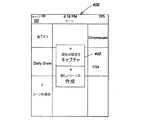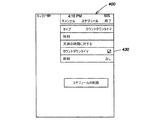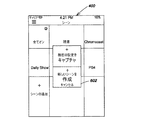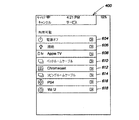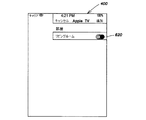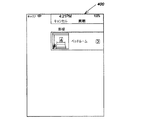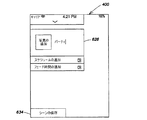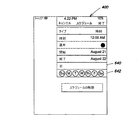JP2017535209A - User-defined scenes for home automation - Google Patents
User-defined scenes for home automation Download PDFInfo
- Publication number
- JP2017535209A JP2017535209A JP2017533163A JP2017533163A JP2017535209A JP 2017535209 A JP2017535209 A JP 2017535209A JP 2017533163 A JP2017533163 A JP 2017533163A JP 2017533163 A JP2017533163 A JP 2017533163A JP 2017535209 A JP2017535209 A JP 2017535209A
- Authority
- JP
- Japan
- Prior art keywords
- user
- states
- home automation
- defined scene
- devices
- Prior art date
- Legal status (The legal status is an assumption and is not a legal conclusion. Google has not performed a legal analysis and makes no representation as to the accuracy of the status listed.)
- Pending
Links
- 238000004378 air conditioning Methods 0.000 claims abstract description 9
- 238000004891 communication Methods 0.000 claims abstract description 9
- 230000004044 response Effects 0.000 claims description 24
- 238000000034 method Methods 0.000 claims description 23
- 230000004913 activation Effects 0.000 claims description 8
- 230000003213 activating effect Effects 0.000 abstract description 2
- 230000009471 action Effects 0.000 description 6
- 230000002085 persistent effect Effects 0.000 description 6
- 238000013507 mapping Methods 0.000 description 5
- 230000000875 corresponding effect Effects 0.000 description 4
- 238000010586 diagram Methods 0.000 description 4
- 230000006870 function Effects 0.000 description 4
- 238000012986 modification Methods 0.000 description 4
- 230000004048 modification Effects 0.000 description 4
- 230000003993 interaction Effects 0.000 description 3
- 230000000694 effects Effects 0.000 description 2
- 230000014509 gene expression Effects 0.000 description 2
- 238000012545 processing Methods 0.000 description 2
- 230000006978 adaptation Effects 0.000 description 1
- 230000001276 controlling effect Effects 0.000 description 1
- 238000004134 energy conservation Methods 0.000 description 1
- 238000012423 maintenance Methods 0.000 description 1
- 238000012544 monitoring process Methods 0.000 description 1
- 239000007787 solid Substances 0.000 description 1
- 238000013403 standard screening design Methods 0.000 description 1
Images
Classifications
-
- G—PHYSICS
- G05—CONTROLLING; REGULATING
- G05B—CONTROL OR REGULATING SYSTEMS IN GENERAL; FUNCTIONAL ELEMENTS OF SUCH SYSTEMS; MONITORING OR TESTING ARRANGEMENTS FOR SUCH SYSTEMS OR ELEMENTS
- G05B15/00—Systems controlled by a computer
- G05B15/02—Systems controlled by a computer electric
-
- H—ELECTRICITY
- H04—ELECTRIC COMMUNICATION TECHNIQUE
- H04L—TRANSMISSION OF DIGITAL INFORMATION, e.g. TELEGRAPHIC COMMUNICATION
- H04L12/00—Data switching networks
- H04L12/28—Data switching networks characterised by path configuration, e.g. LAN [Local Area Networks] or WAN [Wide Area Networks]
- H04L12/2803—Home automation networks
- H04L12/2823—Reporting information sensed by appliance or service execution status of appliance services in a home automation network
- H04L12/2827—Reporting to a device within the home network; wherein the reception of the information reported automatically triggers the execution of a home appliance functionality
- H04L12/2829—Reporting to a device within the home network; wherein the reception of the information reported automatically triggers the execution of a home appliance functionality involving user profiles according to which the execution of a home appliance functionality is automatically triggered
-
- H—ELECTRICITY
- H04—ELECTRIC COMMUNICATION TECHNIQUE
- H04L—TRANSMISSION OF DIGITAL INFORMATION, e.g. TELEGRAPHIC COMMUNICATION
- H04L12/00—Data switching networks
- H04L12/28—Data switching networks characterised by path configuration, e.g. LAN [Local Area Networks] or WAN [Wide Area Networks]
- H04L12/2803—Home automation networks
- H04L2012/2847—Home automation networks characterised by the type of home appliance used
- H04L2012/285—Generic home appliances, e.g. refrigerators
Abstract
ホームオートメーションシステムにおいてシーンを定義し起動させるための教示が提供される。一実施形態では、ホームオートメーションシステムの現在の状態と最後のメディアクエリに基づいてユーザ定義シーンが自動的にキャプチャされる。複数のサービスについてホームオートメーションシステムの現在の状態が自動的にキャプチャされて一組の状態が構築され、該一組の状態は、複数の異なるタイプの装置により提供される複数のサービスの状態を含み、該複数の異なるタイプは、オーディオ/ビデオ(A/V)装置、照明装置、冷暖房空調(HVAC)装置、セキュリティ装置、ブラインド制御装置、省エネルギー装置、又は通信装置のうちの2つ以上を含む。ホームオートメーションシステムにより実行された最後のメディアクエリもまたキャプチャされる。それら両者からユーザ定義シーンが生成される。該ユーザ定義シーンは格納され、及びそれが起動されるべきことが判定された場合に、サービス要求が送信される。【選択図】図1Instructions are provided for defining and activating scenes in home automation systems. In one embodiment, user-defined scenes are automatically captured based on the current state of the home automation system and the last media query. The current state of the home automation system is automatically captured for multiple services to build a set of states, which includes the states of multiple services provided by different types of devices. The plurality of different types include two or more of an audio / video (A / V) device, a lighting device, an air conditioning and air conditioning (HVAC) device, a security device, a blind control device, an energy saving device, or a communication device. The last media query executed by the home automation system is also captured. A user-defined scene is generated from both of them. The user-defined scene is stored and a service request is sent if it is determined that it should be activated. [Selection] Figure 1
Description
本発明は、一般にホームオートメーションシステムに関し、特にホームオートメーションシステムにおけるシーンの使用に関する。 The present invention relates generally to home automation systems, and more particularly to the use of scenes in home automation systems.
ホームオートメーションシステムは、居住建築及び商業建築の両方で次第に一般的なものとなりつつある。かかるシステムは、広範な複数の装置(例えば、オーディオ/ビデオ(A/V)装置、冷暖房空調(HVAC)装置、セキュリティ装置、省エネルギー(energy conservation )装置、通信装置、電話装置、及び/又はその他のタイプの装置)の制御、切替、それら装置とのデータ交換及びその他の相互作用を可能とするものである。しばしば、ユーザは、ホームオートメーションシステムにおいて、複数の装置を個々に選択してそれら装置が実行すべきアクションを指示することにより、所望の複数のアクションを指示する。例えば、ユーザは、照明器具を選択して、該照明器具のスイッチを入れるべきことを指示することが可能である。この種の制御は、比較的限られた数の装置を含むホームオートメーションシステムには妥当なものとなるが、多数の装置を有するシステムでは限界があることが分かっている。かかるシステムでは、ユーザは、単一の選択又はトリガに応じた多数の装置の同時制御を伴う一層複雑なエクスペリエンスを所望し得る。 Home automation systems are becoming increasingly common in both residential and commercial buildings. Such systems include a wide variety of devices (eg, audio / video (A / V) devices, air conditioning (HVAC) devices, security devices, energy conservation devices, communication devices, telephone devices, and / or other devices. Type of devices), switching, data exchange with these devices and other interactions. Often, in a home automation system, a user indicates a desired plurality of actions by individually selecting a plurality of devices and indicating the actions to be performed by those devices. For example, the user can select a luminaire and indicate that the luminaire should be switched on. While this type of control is reasonable for home automation systems with a relatively limited number of devices, it has been found to be limited in systems with a large number of devices. In such a system, the user may desire a more complex experience with simultaneous control of multiple devices in response to a single selection or trigger.
システムによっては、複数のマクロ又は「シーン」の生成を可能とするものがあり、該シーンは、その起動時に、複数の装置の集合体を所定の態様で制御することができるものである。例えば、シーンは、朝の起床条件のためにプログラムすることが可能であり、該シーンは、その起動時に、ベッドルーム内の照明を明るくし、低音量でBGMを流し、ブラインドを開け、浴室の照明をオンにする、といったことをホームオートメーションシステムに行わせることが可能である。同様に、シーンは、他のタイプのエクスペリエンスのためにプログラムすることが可能である。 Some systems allow the generation of a plurality of macros or “scenes” that can control a collection of devices in a predetermined manner upon activation. For example, a scene can be programmed for a morning wake-up condition, which, when activated, brightens the lighting in the bedroom, plays BGM at low volume, opens the blinds, opens the bathroom It is possible to let the home automation system do things such as turning on the lighting. Similarly, a scene can be programmed for other types of experiences.
複数のシーンの使用は、ホームオートメーションシステムにおける制御を強化することを可能にするが、そもそも、かかる複数のシーンは一般にプログラムするのが困難であり時間を要するものである。ホームオートメーションシステムによっては、特定のタイプのシーンをプログラムするために専用のコードを書かなければならないものがある。何らかの類のシーン生成用グラフィカルユーザインタフェイス(GUI)を提供する別のホームオートメーションシステムでは、シーンを定義するために、装置の長々としたシリーズとそれに対応する複数のアクションの選択を手作業で入力しなければならない。シーンをプログラムする者は、システム構成を詳細に理解し、アクションを行うべき各装置とそのアクションが厳密に如何なるものであるべきかを理解し、次いでかかる情報を手作業で入力する必要がある。これは、時間を要し、間違いを起こしやすいものである。その結果として、多くのエンドユーザは、自分自身のシーンを作成せず、その代わりに限られた数の一組の既に利用可能なシーン(例えば、ホームオートメーションシステムで予め定義されているシーン、又は初期システム設定の一部として設置者によりプログラムされたシーン)に依存し、又は装置の個々の制御に依存することとなる。 The use of multiple scenes allows for enhanced control in home automation systems, but in the first place such multiple scenes are generally difficult to program and time consuming. Some home automation systems require you to write specialized code to program a particular type of scene. Another home automation system that provides some sort of graphical user interface (GUI) for scene generation, manually selects a lengthy series of devices and corresponding actions to define the scene. Must be entered. The person who programs the scene needs to understand the system configuration in detail, understand each device to perform an action and what exactly the action should be, and then manually enter such information. This is time consuming and prone to error. As a result, many end-users do not create their own scenes, but instead have a limited number of sets of already available scenes (e.g., predefined scenes in home automation systems, or Depending on the scene programmed by the installer as part of the initial system setup, or on the individual control of the device.
したがって、ホームオートメーションシステムにおけるシーンをエンドユーザが容易に定義し起動することを可能にする改善された技術が必要とされている。 Therefore, there is a need for improved techniques that allow end users to easily define and activate scenes in home automation systems.
ホームオートメーションシステムにおけるシーンをエンドユーザが容易に定義し起動することを可能にする技術が提供される。一実施形態では、ホームオートメーションシステムの現在の動作状態の特徴の「スナップショット」を有効に取得するように該ホームオートメーションシステムにおけるサービスの現在の状態からユーザ定義シーンがキャプチャされる。シーンを定義するために、サービスの現在の状態を自動的にキャプチャして一組の状態を構築することが可能である。更に、現在再生中(又は最後に再生した)メディアアイテム(例えば、歌曲、アルバム、プレイリスト、映画など)を示す1つ以上の最後のメディアクエリをキャプチャすることが可能である。ユーザは、関心のある1つ以上の部屋を選択し、及び、各部屋毎に、関心のある1つ以上のサービスを選択することが可能である。次いで、該関心のある部屋及び/又はサービスに関する該現在の状態及び該最後のメディアクエリからシーンを生成することが可能である。ユーザ入力に応じて該シーンに対する必要な修正が施された後、該シーンを持続的に格納することが可能である。その後、所定のスケジュール又はユーザによる起動に応じて前記ユーザ定義シーンを起動して、該ユーザ定義シーンの前記一組の状態を再現(replicate)するように前記ホームオートメーションシステムにサービスの制御及びメディアアイテムの再生を行わせることが可能である。 Techniques are provided that allow end users to easily define and activate scenes in home automation systems. In one embodiment, a user-defined scene is captured from the current state of the service in the home automation system to effectively obtain a “snapshot” of the current operational state characteristics of the home automation system. To define a scene, it is possible to automatically capture the current state of the service and build a set of states. Further, it is possible to capture one or more last media queries that indicate media items that are currently playing (or last played) (eg, songs, albums, playlists, movies, etc.). The user can select one or more rooms of interest and, for each room, select one or more services of interest. A scene can then be generated from the current state and the last media query for the room and / or service of interest. After the necessary modifications to the scene are made in response to user input, the scene can be stored persistently. Thereafter, service control and media items are provided to the home automation system to activate the user-defined scene in response to a predetermined schedule or activation by a user and replicate the set of states of the user-defined scene. Can be played back.
「課題を解決するための手段」で説明したもの以外に様々な更なる特徴及び代替的な実施形態を実施することが可能であることが理解されよう。「課題を解決するための手段」は、読者に対する簡単な導入を意図したものに過ぎず、及び本書で言及する実施形態が本開示の全ての特徴を網羅するものであること又は本開示の不可欠な又は本質的な特徴を有するものであることを示し又は示唆するものではない。 It will be appreciated that various further features and alternative embodiments may be implemented other than those described in “Means for Solving the Problems”. "Means for solving the problem" is only intended to be a brief introduction to the reader, and the embodiments mentioned in this document are intended to cover all the features of the present disclosure or are indispensable to the present disclosure. It does not indicate or imply that it has any or essential characteristics.
[ホームオートメーションシステムの実例]
図1は、特定の建築物(例えば、住宅建築物又は商業建築物)に関する複数の装置を制御するよう動作することが可能なホームオートメーションシステム100の例示的なアーキテクチャを示すブロック図である。該システム100の核となるのが、1つ以上の装置コントローラ110及びホストコントローラ140である。該1つ以上の装置コントローラ110は、様々な相互接続された装置120-132間で信号を切り替え及びそれら装置に低レベル制御を提供するよう動作する。該ホストコントローラ140は、装置コントローラ110の動作を制御し及び監視し、並びに、ユーザインタフェイス(UI)による翻訳(interpretation)、システム管理及び監視、及び/又は高レベル制御機能を提供する。ホームオートメーションシステム100との対話のためのUIは、様々なタイプの制御装置150上でユーザに対して表示することが可能である。
[Example of home automation system]
FIG. 1 is a block diagram illustrating an exemplary architecture of a
より詳細には、装置コントローラ110は、存在する様々な装置120-132に対して、N×Nスイッチング、オーディオ及びビデオ処理、装置制御、及びその他の管理機能を提供することが可能である。該装置120-132は、オーディオ及び/又はビデオ信号の出所となるソース装置にカテゴライズされたA/V装置120(例えば、メディアサーバ、ケーブルテレビ用チューナー(cable box)、ディジタルビデオディスク(DVD)プレーヤ、メディアプレーヤなど)、オーディオ及び/又はビデオ信号を操作する処理装置(プリアンプ、ディジタル信号プロセッサ、アンプなど)、及びオーディオ及び/又はビデオ信号を出力する出力装置(例えば、テレビ、スピーカ、プロジェクタなど)を含むことが可能である。該装置120-132はまた、照明装置122(例えば、照明コントローラ、キーパッド、ランプモジュールなど)を含むことが可能である。更に、1つ以上の自動温度調節装置、サーモスタット、センサなどを含む冷暖房空調(HVAC)装置124を配設することが可能である。モーションセンサ、監視カメラ、ホームヘルスケアセンサ、及びそれらに関連するコントローラなどを含むセキュリティ装置126を装置コントローラ110に接続することも可能である。更に、モータ駆動式ブラインド(window shades)、モータ駆動式シャッター(window blinds)、及びそれらに関連するコントローラなどを含むブラインド制御装置128を配設することが可能である。1つ以上のエネルギーモニタ、変流器、電圧センサなどを含む省エネルギー装置130を配設することが可能である。更に、構内電話交換機(PBX)、ゲートウェイ、ハンドセット、及びその他の装置を用いた、電話、インターホン、及びその他の関連する機能を提供する通信装置132が存在することが可能である。
More particularly, the
ホストコントローラ140は、典型的には、ソフトウェアを実行してデータ構造からのデータを操作するよう構成されたプロセッサ、及び該ソフトウェア及び該データ構造を格納するための記憶場所を含む記憶装置(例えば、持続性又は揮発性メモリ、ハードディスク、SSD(Solid State Drive)など)を含む。該データ構造は、コンフィギュレーションデータベース(例えば、SQL(Structured Query Language)データベース等のリレーショナルデータベースとして構築されたもの)190を含むことが可能である。該コンフィギュレーションデータベース190は、論理表現を使用してホームオートメーションシステム100及びその装置120-132のコンフィギュレーションを記述すること並びに他のタイプの情報を維持することが可能である。前記ソフトウェア及び前記データ構造はまた、ホームオートメーションシステム100の現在の動作状態を記述する情報を格納する状態センター192を含むことが可能である。該動作状態は、装置120-132により提供される複数のサービスの複数の離散的な状態として表す(例えば、オン又はオフ等の情報を示すブール値、程度(degree)又は音量等の情報を示す数値、又はその他のタイプの情報を示すその他のタイプの値として表す)ことが可能である。ホストコントローラ140上のソフトウェアは、制御装置150と協働し並びにコンフィギュレーションデータベース190及び状態センター192と対話して「ユーザ定義シーン」を管理するシーンエンジン194を含むことが可能である。本書で用いる場合、用語「ユーザ定義シーン」とは、特定の状態をとり及び/又はエンドユーザにより所望されることが指示された特定のメディア時間を再生する、複数のサービスを提供する、複数の装置によって引き起こされる所与の建築物の一部内でのマルチメディアエクスペリエンスを意味する。ユーザ定義シーンの生成、メンテナンス、及び起動に関する更なる詳細については以下で説明することとする。
The
制御装置150は、モバイル装置152、リモコン装置154、デスクトップコンピュータ(例えば、PC)といった様々な形態をとることが可能である。本書で用いる場合、用語「モバイル装置」とは、汎用オペレーティングシステムを実行し身に着けて搬送されるよう構成された汎用的な電子装置を意味する。タブレットコンピュータ(例えば、iOS(登録商標)オペレーティングシステムを実行するiPad(登録商標)タブレット)及びスマートフォン(例えば、iOS(登録商標)オペレーティングシステムを実行するiPhone(登録商標)スマートフォン又はAndroid(登録商標)を実行するAndroid(登録商標)スマートフォン)等の装置は、モバイル装置とみなされる。デスクトップコンピュータは一般にモバイル装置とはみなされない。本書で用いる場合、用語「リモコン装置」は、ホームオートメーションシステム又はその一部を制御するよう構成されたポータブル専用電子装置を意味する。典型的には、リモコン装置は、汎用的な操作には適さず、1つ以上のタイプのホームオートメーションシステムで動作するよう構成されたものである。
The
制御装置150は、そのタイプにかかわらず、典型的には、ソフトウェアを実行してデータ構造からのデータを操作するよう構成されたプロセッサ、及び該ソフトウェア及び該データ構造を格納するための記憶場所を含む記憶装置(例えば、持続性又は揮発性メモリ、ハードディスク、SSDなど)を含む。更に、制御装置150は、典型的には、ディスプレイスクリーン(例えば、タッチセンサ式ディスプレイスクリーン)を含む。制御装置150はまた、ポータブル電源(例えば、バッテリー)、ワイヤレス通信インタフェイス、入力装置(例えば、ボタン、カメラ、方位センサなど)といった様々な他のタイプのハードウェアを含むことが可能である。
Regardless of its type, the
複数の制御装置150の各々は、UIをユーザに提示し及び(例えば、ワイヤレスローカルエリアネットワーク(WLAN)等のワイヤレス接続を介して)制御コマンドを中継してホストコントローラ140へ送り返すアプリケーション(例えば、制御アプリケーション160)を実行することが可能である。該制御アプリケーション160は、制御ソフトウェア開発キット(SDK)162(その機能の中でもとりわけ、コンフィギュレーションデータベース190及び状態センター192に対する照会及びシーンエンジン194との対話を行うための方法を提供するもの)を利用することが可能である。場合によっては、コンフィギュレーション情報及び/又は状態情報のローカルコピーを制御装置150に送信(例えばダウンロード)して該制御装置150上で維持することが可能である。例えば、コンフィギュレーションデータベース190のローカルコピーを制御装置150上で維持することが可能である。制御SDK162は、ローカル版の情報が旧くなったとき(又はローカル版が存在しない場合)を検出し、及び更新された情報をホストコントローラ140から取得することを責務とすることが可能である。
[論理表現の実例]
コンフィギュレーションデータベースは、様々な異なるタイプの論理表現を使用して、ホームオートメーションシステム100及びその装置120-132のコンフィギュレーションを記述することが可能である。例えば、該論理表現は、とりわけ、「部屋」、「コンポーネント」、「サービス」、及び「サービス要求」を含むことが可能である。
Each of the plurality of
[Example of logical expression]
The configuration database can describe the configuration of the
ここで、「部屋」とは、ユーザが1つ以上のホームオートメーション活動(activities)に参加することが可能な所与の建築物の一部を意味する。1つの「部屋」は、該建築物内の物理的な1つの部屋又は別の所与の空間の一領域に対応することが可能である。 As used herein, “room” means a portion of a given building that allows a user to participate in one or more home automation activities. A “room” can correspond to a physical room in the building or an area of another given space.
「コンポーネント」とは、ホームオートメーションシステムの制御下にある装置を意味する。1つのコンポーネントには、1つのプロファイル(例えば、その装置の能力及び入出力(I/O)インタフェイスのマシン読み取り可能なマークアップ言語(例えば、XML)による記述)を関連付けることが可能である。 “Component” means a device under the control of a home automation system. A component can be associated with a profile (e.g., a description of the device's capabilities and an input / output (I / O) interface in a machine-readable markup language (e.g., XML)).
「サービス」とは、1つ以上の部屋で一人のユーザが参加することができる活動を意味し、該活動は、所定のユーザエクスペリエンスを提供する複数のコンポーネントの対話を伴うものである。例えば、考え得る1つのサービスを、ユーザがケーブルテレビを観る「ケーブルTV」サービスとすることが可能であり、該ケーブルTVサービスは、特定のコンポーネント(例えば、ケーブルテレビ用チューナ、テレビ、スピーカ、メディアスイッチ(media switch)、及び受信機)を使用する。 “Service” means an activity that allows a single user to participate in one or more rooms, which involves the interaction of multiple components that provide a predetermined user experience. For example, one possible service could be a “cable TV” service where a user watches cable TV, which is a specific component (eg, cable TV tuner, TV, speaker, media Media switch and receiver).
「サービス要求」(又は要求)は、所与のサービスによりサポートされるコマンドを意味する。例えば、上述した「ケーブルTV」サービスの要求は、「チャネル増大(channel up)」、「チャネル減少(channel down)」、「音量増大」、「音量減少」などとすることが可能である。サービス要求を使用することにより、サービスを制御することが可能である。
[シーンオブジェクトの実例]
これらの論理表現に基づき、「シーンオブジェクト」においてユーザ定義シーンを維持することが可能である。図2は、ユーザ定義シーンを維持するためにシーンエンジン194により使用することが可能な例示的なシーンオブジェクト200を示すブロック図である。該シーンオブジェクト200は、一意のシーン識別子(ID)202並びにユーザにより提供された名前文字列204により識別することが可能である。複数の高レベルデータ構造(例えば、キー/値の対を格納した辞書)を配設することも可能である。該高レベルデータ構造は、該データ構造の中でもとりわけ、電源データ構造(例えば、電源辞書)210、音量データ構造(例えば、音量辞書)220、及びサービスデータ構造(例えば、サービス辞書)230を含むことが可能である。
“Service request” (or request) means a command supported by a given service. For example, the “cable TV” service request described above can be “channel up”, “channel down”, “volume up”, “volume down”, and so on. By using service requests, it is possible to control services.
[Scene object example]
Based on these logical expressions, it is possible to maintain a user-defined scene in a “scene object”. FIG. 2 is a block diagram illustrating an
電源データ構造210は、装置120-132をユーザ定義シーンによってオンにすべきか、オフにすべきか、又は不変のままにすべきかを定義することが可能である。この場合、該電源データ構造210は、対応する部屋でサービスの電源をオンにすべきかオフにすべきかを示す指示(例えば、ブール)と共に、A/V装置120を伴う複数のサービスへの複数の部屋のマッピングを含むA/V部屋構造(例えば、A/V部屋キー)212(例えば、A/V装置120を伴うサービスの辞書へとマッピングされた部屋の辞書)を含むことが可能である。部屋がどのサービスにもマッピングされていない場合には、その部屋内の全てのA/V装置120の電源がオフにされるべきであるとみなすことができる。所与の部屋がA/V部屋構造212に含まれていない場合には、該部屋内のA/V装置120の電源状態がユーザ定義シーンにより変更されないものとみなすことが可能である。更に、電源データ構造210は、ユーザ定義シーンにより照明装置122の電源が全てオフにされている部屋を示す照明オフ構造(例えば、一連の部屋)214を含むことが可能である。同様に、電源データ構造210は、ユーザ定義シーンによりHVAC装置124の電源が全てオフにされている部屋を示すHVACオフ構造(例えば、一連の部屋)216を含むことが可能である。
The
更に、音量データ構造220は、各部屋毎に音量を定義することが可能である。所与の部屋の音量が指定されていない場合には、該部屋の音量を不変のままにするものとみなすことが可能である。更に、サービスデータ構造230は、サービスに関連して提供される状態変化を定義することが可能である。サービスデータ構造230は、コンポーネントによってキーイングする(keyed)ことが可能であり、及び影響を受ける部屋のリスト及び状態変化のリストを含むエントリを含むことが可能である。該状態変化のリスト中に状態が挙げられていない場合には、不変状態のままとすることが可能である。
Further, the
シーンオブジェクト200は、多数のコマンドに応答することが可能であり、かかるコマンドとして、ユーザ定義シーンを削除する削除コマンド、ユーザ定義シーンを直ちに適用する適用コマンド、スケジューリングされたユーザ定義シーンを起動させるスケジュール起動コマンド、スケジューリングされたユーザ定義シーンを解除するスケジュール解除コマンド、新しいユーザ定義シーンを現在の状態の自動キャプチャから作成するために使用することができるキャプチャコマンド、新しいユーザ定義シーンをユーザにより供給された状態から作成するために使用することができる作成コマンド、並びに様々な他のコマンドが挙げられる。
[シーンの定義]
シーンオブジェクト200内に維持されるユーザ定義シーンは、多数の異なる態様で(例えば、シーンオブジェクト200のキャプチャコマンド及び作成コマンドに関連して)定義することが可能である。一実施形態では、キャプチャコマンドに関連して、ホームオートメーションシステムの現在の動作状態の特徴の「スナップショット」を効果的に取得するための、サービスの現在の状態の自動キャプチャによって、ユーザ定義シーンを定義することが可能である。シーンエンジン194は、(例えば、状態センター192から現在の状態をフェッチすることにより)サービスの現在の状態を自動的にキャプチャして一組の状態を構築することが可能である。シーンエンジン194はまた、現在再生中の(又は最後に再生した)メディアアイテム(例えば、歌曲、アルバム、プレイリスト、映画など)を示す1つ以上の最後のメディアクエリを(例えば、メディアサーバ等のA/V装置120の保存された再生アクションにアクセスすることにより)自動的にキャプチャすることが可能である。ユーザは、(例えば、制御装置150上の制御アプリケーション160のUI中の)関心のある1つ以上の部屋を選択し、及び該選択した各部屋毎に、関心のある1つ以上のサービスを選択することが可能である。シーンエンジン194は、次いで、前記1つ以上の部屋についての前記現在の状態及び前記最後のメディアクエリ及び/又は前記サービスから、ユーザ定義シーンを生成することが可能である。(例えば、制御装置150上の制御アプリケーション160のUIでの更なるユーザ入力に応じて)前記ユーザ定義シーンに対するあらゆる必要な修正が行われた後、該ユーザ定義シーンは、コンフィギュレーションデータベース190内のシーンオブジェクト200内に持続的に格納することが可能である。
The
[Definition of the scene]
User-defined scenes maintained within the
代替的に実施形態では、作成コマンドに関連して、ユーザにより供給された状態に基づいてユーザ定義シーンを作成することが可能である。ユーザは、例えば、制御装置150上の制御アプリケーション160のUIを使用して、関心のある1つ以上のサービスを選択し、その選択した各サービス毎に、該サービスを利用可能とする1つ以上の部屋を選択することが可能である。ユーザはまた、各部屋毎に、(例えば、オン又はオフ等の情報を示すブール値、程度又は音量等の情報を示す数値、又はその他のタイプの情報を示すその他のタイプの値として表された)1つ以上の明示的な状態を供給することが可能である。次いで、シーンエンジン194は、前記ユーザにより供給された状態からユーザ定義シーンを生成することが可能である。該ユーザ定義シーンに対して(例えば、制御アプリケーション160のUIにおける更なるユーザ入力に応じて)必要な修正が施された後、該ユーザ定義シーンは、コンフィギュレーションデータベース190内のシーンオブジェクト200内に持続的に格納することが可能である。
Alternatively, in an embodiment, a user-defined scene can be created based on the state supplied by the user in connection with the creation command. The user may select one or more services of interest using, for example, the UI of the
シーンを定義するためのかかる技術に関する更なる詳細を以下で説明する。
[i.ユーザ定義シーンの自動キャプチャ]
図3は、ホームオートメーションシステムにおけるサービスの現在の状態に基づいてユーザ定義シーンを自動的にキャプチャするための例示的な一連のステップ300を示すフローチャートである。それらステップは、制御装置150上の制御アプリケーション160のUI400の例示的なスクリーンショットである図4A〜4Mを参照することにより一層良好に理解することが可能である。ステップ310で、及び図4Aに関し、UI要素402の選択により、現在の状態に基づくユーザ定義シーンのキャプチャが開始する。
Further details regarding such techniques for defining a scene are described below.
[i. Automatic capture of user-defined scenes]
FIG. 3 is a flowchart illustrating an exemplary series of
ステップ315で、シーンエンジン194は、キャプチャすべき状態を決定することが可能である。ステップ315は、ホームオートメーションシステムの様々なタイプの装置により提供されるサービスに関する状態についてのサブステップを含むことが可能である。例えば、サブステップ316で、シーンエンジン194は、複数のA/V装置120により提供される複数のサービスのキャプチャすべき1つ以上のA/V状態を決定することが可能である。ステップ317で、シーンエンジン194は、照明装置122により提供される複数のサービスのキャプチャすべき1つ以上の照明状態を決定することが可能である。ステップ318で、シーンエンジン194は、HVAC装置124により提供される複数のサービスのキャプチャすべき1つ以上のHVAC状態を決定することが可能である。同様に、その他のサブステップ(図示せず)で、シーンエンジン194は、その他のタイプの装置により提供される複数のサービスのキャプチャすべき1つ以上のその他の状態を決定することが可能である。ステップ320で、シーンエンジン194は、それら状態を一組の状態へと統合することが可能である。更に、ステップ325で、シーンエンジン194は、状態センター192からフェッチすることにより該一組の状態について現在の状態を決定することが可能である。ステップ330で、シーンエンジン194は、現在再生中の(又は最後に再生した)アイテムを示す1つ以上の最後のメディアクエリを決定することが可能である。シーンエンジン194は、メディアサーバ等のA/V装置120の1つ以上の保存された再生アクションにアクセスして最後のメディアクエリを取得することが可能である。
At
ステップ335で、及び図4B〜4Cに関し、関心のある1つ以上の部屋のユーザ選択をUI400内で受けることが可能である。部屋を表す1つ以上のUI要素404,406を表示させることが可能である。該UI要素の選択に応じて、標識408,410は、部屋の選択を確認することが可能である。該1つ以上の選択された部屋は、建築物内の定義された部屋の総数のサブセットとすることが可能である。ステップ340で、及び図4Dに関し、関心のある1つ以上のサービスのユーザ選択をUI400で受けることも可能である。該ユーザ選択は、個々の部屋で利用可能なサービスを表すUI400内の1つ以上のUI要素412-418から行うことが可能である。次いでステップ345で、シーンエンジン194は、該選択された部屋及びサービスに関する現在の状態及び最後のメディアクエリからユーザ定義シーンを生成することが可能である。図4Eに示すように、要約420を表示させることが可能である。ステップ350で、シーンエンジン194は、例えば、UI要素434のアクティブ化に応じて、前記ユーザ定義シーンをコンフィギュレーションデータベース190内に格納することが可能である。該ユーザ定義シーンの格納の一部として、UI要素422でのユーザ入力に応じて、該ユーザ定義シーンに名前及び/又は写真を関連付けることが可能である。
At
ステップ355で、及び図4F〜4Kに関し、制御アプリケーション160は、UI400におけるユーザ入力に応じてユーザ定義シーンを修正することが可能である。例えば、UI要素424-430におけるユーザ入力に応じて、ユーザ定義シーンを起動させるためのスケジューリングを行うことが可能である。例えば、UI要素426におけるユーザ入力に応じて、一日の特定の時刻に達したときに起動させるようシーンをスケジューリングすることが可能である。同様に、UI要素428におけるユーザ入力に応じて、天体的な基準(例えば、夜明け、日暮れなど)に達したときにユーザ定義シーンを起動させるようスケジューリングすることが可能である。同様に、UI要素428-432におけるユーザ入力に応じて、カウントダウンタイマーが満了したときにユーザ定義シーンを起動させるようスケジューリングすることが可能である。ステップ360で、及び図4Lに関し、例えば、UI要素434のアクティブ化に応じて、更新されたユーザ定義シーンをコンフィギュレーションデータベース190内に持続的に格納することが可能である。その後、図4Mに関し、ユーザ定義シーンに関するシーンUI要素436を制御アプリケーション160のUI400内に表示させることが可能である。該ユーザ定義シーンは、シーンUI要素436の選択に応じて又は上述したスケジューリング基準のうちの1つに応じて起動させることが可能である。
[ユーザ定義シーンの作成]
図5は、ユーザにより供給された状態に基づいてユーザ定義シーンを作成するための例示的な一連のステップ500を示すフローチャートである。かかるステップは、制御装置150上の制御アプリケーション160のUI400の例示的なスクリーンショットである図6A〜6Kを参照することにより一層良好に理解することが可能である。ステップ510で、及び図6Aに関し、UI要素602のユーザ選択により、ユーザにより供給された状態に基づくユーザ定義シーンの作成が開始する。ステップ515で、及び図6Bに関し、サービスのユーザ選択をUI400で受けることが可能である。該ユーザ選択は、利用可能なサービスを表すUI400内の1つ以上のUI要素605-618から行うことが可能である。ステップ520で、及び図6Cに関し、部屋の状態のユーザ選択をUI400で受けることが可能である。該ユーザ選択は、UI400内のUI要素620で行うことが可能である。図6Cには単一のUI要素620しか示していないが、1つのサービスが複数の部屋で利用可能である場合には、複数の対応するUI要素620を表示して、複数の部屋の状態を個々に選択できるようにすることが可能であることが理解されよう。ステップ515,520は、ユーザが完全な一組の状態の供給を完了するまで繰り返すことが可能である。図6Dに示すように、要約622を表示させることが可能である。更に、サブステップ522で、及び図6E〜6Fに関し、何れかの部屋における何れかのタイプのサービス(例えば、照明サービス)に関し、サービスを提供する複数の装置(例えば、照明器具)又は複数の装置グループを指示するよう状態のユーザ選択を改良することが可能である。図6Fには単一のUI要素624しか示していないが、サービスを提供することが可能な複数の装置(例えば、複数の照明器具)又は複数の装置グループが存在する場合には、それらに対応する複数のUI要素624を個々の改良を可能にすべく表示することが可能であることが理解されよう。
In
[Create user-defined scene]
FIG. 5 is a flowchart illustrating an exemplary series of
ステップ525で、シーンエンジン194は、ホームオートメーションシステムにより実行された最後のメディアクエリ(例えば、アクセスした最後のオーディオ及び/又はビデオコンテンツ)を決定することが可能である。次いで、ステップ530で、シーンエンジン194は、前記ユーザにより供給された状態及び前記最後のメディアクエリからユーザ定義シーンを生成することが可能である。ステップ535で、及び図6Gに関し、シーンエンジン194は、UI要素634のアクティブ化に応じて、該ユーザ定義シーンをコンフィギュレーションデータベース190内に格納することが可能である。該ユーザ定義シーンの格納の一部として、UI要素626におけるユーザ入力に応じて、名前及び/又は写真を該ユーザ定義シーンに関連付けることが可能である。
At
ステップ540で、及び図6H〜6Jに関し、制御アプリケーション160は、UI400におけるユーザ入力に応じてユーザ定義シーンを修正することが可能である。例えば、UI要素628-642におけるユーザ入力に応じて、特定の月の特定の日の特定の時刻に起動するようユーザ定義シーンをスケジューリングすることが可能である。代替的には、天体的な基準(例えば、夜明け、日暮れなど)に達したとき、カウントダウンタイマーが満了したとき、又は他の何らかのトリガがアクティブになったときにユーザ定義シーンを起動させるようスケジューリングすることが可能である。ステップ545で、及び図6Kに関し、更新されたユーザ定義シーンを、例えば、UI要素634の選択に応じて、コンフィギュレーションデータベース190内に持続的に格納することが可能である。その後、該ユーザ定義シーンのためのシーンUI要素を制御アプリケーション160のUI400内に表示させることが可能である。該ユーザ定義シーンは、該シーンUI要素の選択に応じて、又は上述した複数のスケジューリング基準のうちの1つに応じて、起動させることが可能である。
[ユーザ定義シーンの適用]
(例えば、スケジューリング基準、又は起動のためシーンを選択するユーザ入力に応じて)特定のユーザ定義シーンが起動されるべきことが判定されたとき、ホストコントローラ140上のシーンエンジン194は、該ユーザ定義シーンにアクセスし、該ユーザ定義シーンで維持されている状態と格納済みのメディアクエリとを複数のサービス要求へと変換し、それらサービス要求を(例えば、装置コントローラ110を介して)発行してホームオートメーションシステム100の複数の装置を制御することにより、該ユーザ定義シーンを適用することが可能である。図7は、ユーザ定義シーンを適用するための例示的な一連のステップ700を示すフローチャートである。ステップ710で、シーンエンジン194は、コンフィギュレーションデータベース190から対応するシーンオブジェクト200をロードすることによりユーザ定義シーンにアクセスすることが可能である。ステップ720で、シーンエンジン194は、該ユーザ定義シーンで維持されている複数の状態を、特殊なマッピングロジック及び複数のデータテーブルを使用して、複数のサービス要求へと変換することが可能である。ステップ720は、ホームオートメーションシステム100の様々なタイプの複数の装置により提供される複数のサービスに関する複数の状態を変換するための複数のサブステップを含むことが可能である。例えば、サブステップ722で、シーンエンジン194は、複数のA/V装置120により提供される複数のサービスの1つ以上のA/V状態を特殊なマッピングロジックを使用して複数のサービス要求へと変換することが可能である。サブステップ724で、シーンエンジン194は、複数の照明装置122により提供される複数のサービスの1つ以上の照明状態を複数のマッピングデータテーブルを使用して複数のサービス要求へと変換することが可能である。サブステップ726で、シーンエンジン194は、複数のHVAC装置124により提供される複数のサービスの1つ以上のHVAC状態を更なる複数のマッピングデータテーブルを使用して複数のサービス要求へと変換することが可能である。
At
[Apply user-defined scene]
When it is determined that a particular user-defined scene should be activated (e.g., in response to scheduling criteria or user input selecting a scene for activation), the
ステップ730で、シーンエンジン194は、格納されている最後のメディアクエリを要求へと変換することが可能である。更に、ステップ740で、シーンエンジン194は、ユーザ定義シーンに関連付けることが可能なユーザにより指定されたあらゆるサービス要求にアクセスすることが可能である。ステップ750で、全ての変換され又はアクセスされたサービス要求を1つの要求セットへと統合することが可能である。ステップ760で、該要求セットを部屋によって整理する(例えば、順序づけする)ことが可能である。最後に、ステップ770で、ホストコントローラ140は、該要求セットの該整理された(例えば、順序づけされた)複数のサービス要求を(例えば、装置コントローラ110を介して)発行して、ホームオートメーションシステム100の複数の装置により提供される複数のサービスを制御することが可能である。
[結論]
本書で説明した複数の実施形態の思想及び範囲内で様々な適応及び修正を実施することが可能であることが理解されよう。幾つかの実施形態は、A/V制御、照明制御、HVAC制御、セキュリティ制御、ブラインド制御、省エネルギー、及び通信制御を行うことができるホームオートメーションシステムを伴うものであったが、本開示の技術は、一層制限されたシステム、例えば、より少ないタイプの装置(例えば、A/V装置及び照明装置のみ、照明及びHVAC装置のみなど)を制御することが可能なシステムにも適用可能であることが理解されよう。
At
[Conclusion]
It will be understood that various adaptations and modifications may be made within the spirit and scope of the embodiments described herein. Although some embodiments involved home automation systems that can perform A / V control, lighting control, HVAC control, security control, blind control, energy saving, and communication control, the techniques of this disclosure It is understood that it can also be applied to more limited systems, such as systems that can control fewer types of equipment (eg, only A / V equipment and lighting equipment, only lighting and HVAC equipment, etc.) Let's be done.
幾つかの実施形態は、上述した様々な操作を実行するためにシーンエンジン194を使用するものであったが、シーンエンジン194の操作は、他のソフトウェア及び/又はハードウェアにより実施することが可能であることが理解されよう。例えば、該操作の少なくとも幾つかを、制御装置150上で実行しているソフトウェア(例えば、モバイルアプリケーション160)、装置コントローラ110上で実行しているソフトウェア、及び/又はホームオートメーションシステム100の他の何れかの装置上で実行しているソフトウェアにより、行うことが可能である。同様に、少なくとも幾つかの操作を、ホームオートメーションシステム100と通信可能な状態にあるパーソナルコンピュータ(PC)により行うことが可能である。様々な異なる構成が実施可能であることが理解されよう。
Some embodiments have used the
更に、ソフトウェアで実行される上述した技術の多くはハードウェアで実行することが可能であり、その逆もまた同様である。実施態様に応じて、操作を、ソフトウェアで、ハードウェアで、又はその様々な組み合わせで行うことが可能である。ソフトウェアによる実施形態は、持続性マシン読み取り可能媒体(例えば、持続性コンピュータ読み取り可能媒体)(例えば、揮発性又は持続性メモリ、ハードディスク、コンパクトディスク(CD)、又はその他の有形の媒体)に格納されたマシン実行可能命令(例えば、コンピュータ実行可能命令)を含むことが可能である。ハードウェアによる実施形態は、設定された(configured)プロセッサ、論理回路、特定用途向け集積回路(ASIC)、及び/又はその他のタイプのハードウェア要素を含むことが可能である。更に、ソフトウェア/ハードウェアの組み合わせによる実施形態は、持続性マシン読み取り可能媒体に格納されたマシン実行可能命令、並びに1つ以上のハードウェア要素(例えば、プロセッサ、メモリなど)を両方とも含むことが可能である。一般に、上記説明は単なる一例として解釈されるべきものであることが理解されよう。
Furthermore, many of the techniques described above that are implemented in software can be implemented in hardware, and vice versa. Depending on the implementation, operations can be performed in software, hardware, or various combinations thereof. Software embodiments are stored on a persistent machine readable medium (eg, a persistent computer readable medium) (eg, volatile or persistent memory, a hard disk, a compact disk (CD), or other tangible medium). Machine executable instructions (eg, computer executable instructions). Hardware implementations may include configured processors, logic circuits, application specific integrated circuits (ASICs), and / or other types of hardware elements. Further, the software / hardware combination embodiment may include both machine-executable instructions stored on a persistent machine-readable medium, as well as one or more hardware elements (eg, processor, memory, etc.). Is possible. In general, it will be understood that the above description is to be construed as merely an example.
Claims (22)
該サービスについて該ホームオートメーションシステムにおける現在の状態を自動的にキャプチャして一組の状態を構築し、該一組の状態が、複数の異なるタイプの装置により提供される複数のサービスの複数の状態を含み、該複数の異なるタイプが、オーディオ/ビデオ(A/V)装置、照明装置、冷暖房空調(HVAC)装置、セキュリティ装置、ブラインド制御装置、省エネルギー装置、又は通信装置のうちの2つ以上の装置を含み、
前記一組の状態からユーザ定義シーンを生成し、
該ユーザ定義シーンを前記ホームオートメーションシステムの記憶装置に格納し、
該ユーザ定義シーンが起動されるべきことを判定し、
該ユーザ定義シーンの前記一組の状態を再現するよう前記ホームオートメーションシステムの前記複数の異なるタイプの装置により提供される複数のサービスを制御する
ことからなる方法。 Determine multiple services in the home automation system whose status should be captured,
Automatically capturing a current state in the home automation system for the service to build a set of states, the set of states being a plurality of states of a plurality of services provided by a plurality of different types of devices And the plurality of different types includes two or more of an audio / video (A / V) device, a lighting device, an air conditioning / air conditioning (HVAC) device, a security device, a blind control device, an energy saving device, or a communication device. Including equipment,
Generate a user-defined scene from the set of states,
Storing the user-defined scene in a storage device of the home automation system;
Determining that the user-defined scene should be activated;
A method comprising controlling a plurality of services provided by the plurality of different types of devices of the home automation system to reproduce the set of states of the user-defined scene.
前記ユーザ定義シーンを生成することが、前記一組の状態から前記1つ以上の選択された部屋の状態について前記ユーザ定義シーンを生成する、
請求項1に記載の方法。 Determining one or more selected rooms of a plurality of rooms of a building associated with the home automation system;
Generating the user-defined scene generates the user-defined scene for the one or more selected room states from the set of states;
The method of claim 1.
制御装置上で実行している制御アプリケーションのユーザインタフェイスにおいて入力されたユーザ入力を受信することを含み、該ユーザ入力が、前記1つ以上の選択された部屋の各部屋の選択を含む、
請求項2に記載の方法。 Determining the one or more selected rooms;
Receiving user input entered at a user interface of a control application executing on the control device, the user input comprising a selection of each of the one or more selected rooms;
The method of claim 2.
前記ユーザ定義シーンを生成することが、該1つ以上の選択されたサービスの状態についてユーザ定義シーンを生成する
ことを更に含む、請求項1に記載の方法。 Determining one or more selected services of a plurality of services provided by the home automation system;
The method of claim 1, wherein generating the user-defined scene further comprises generating a user-defined scene for the state of the one or more selected services.
制御装置上で実行している制御アプリケーションのユーザインタフェイスにおいて入力されたユーザ入力を受信することを含み、該ユーザ入力が、前記1つ以上の選択されたサービスの各サービスの選択を含む、
請求項4に記載の方法。 Determining the one or more selected services;
Receiving user input entered at a user interface of a control application executing on the control device, the user input comprising a selection of each service of the one or more selected services;
The method of claim 4.
A/V状態がキャプチャされるべき1つ以上のA/Vサービスを決定すること
を含む、請求項1に記載の方法。 Determining a plurality of services for which the state is to be captured;
The method of claim 1, wherein the A / V state includes determining one or more A / V services to be captured.
照明状態がキャプチャされるべき1つ以上の照明サービスを決定すること
を含む、請求項1に記載の方法。 Determining a plurality of services for which the state is to be captured;
The method of claim 1, wherein the lighting condition comprises determining one or more lighting services to be captured.
HVAC状態がキャプチャされるべき1つ以上のHVACサービスを決定すること
を含む、請求項1に記載の方法。 Determining a plurality of services for which the state is to be captured;
The method of claim 1, wherein the HVAC condition comprises determining one or more HVAC services to be captured.
該ホームオートメーションシステムのホストコントローラにより維持される状態センターから前記現在の状態をフェッチすること
を含む、請求項1に記載の方法。 Automatically capturing the current state in the home automation system for the service;
The method of claim 1, comprising fetching the current state from a state center maintained by a host controller of the home automation system.
前記ユーザ定義シーンを生成することが、該最後のメディアクエリを格納することを含む
ことを更に含む、請求項1に記載の方法。 Determining a last media query executed by the home automation system, the last media query indicating an audio or video item;
The method of claim 1, wherein generating the user-defined scene further comprises storing the last media query.
スケジューリングされた所与の時刻に達したことを判定すること
を含む、請求項1に記載の方法。 Determining that the user-defined scene is to be activated;
The method of claim 1, comprising determining that a given scheduled time has been reached.
天体的な基準に達したことを判定すること
を含む、請求項1に記載の方法。 Determining that the user-defined scene is to be activated;
The method of claim 1, comprising determining that an astronomical criterion has been reached.
カウントダウンタイマが満了したことを判定すること
を含む、請求項1に記載の方法。 Determining that the user-defined scene is to be activated;
The method of claim 1, comprising determining that a countdown timer has expired.
制御装置上で実行している制御アプリケーションのユーザインタフェイスにおいてユーザ入力が受信されたことを判定することを含み、該ユーザ入力が、前記ユーザ定義シーンを起動のために選択するものである、
請求項1に記載の方法。 Determining that the user-defined scene is to be activated;
Determining that user input has been received at a user interface of a control application executing on the control device, the user input selecting the user-defined scene for activation;
The method of claim 1.
前記ユーザ定義シーンをロードし、
該ユーザ定義シーンにおいて維持されている複数の状態を複数のサービス要求へと変換し、
該複数のサービス要求を発行して前記ホームオートメーションシステムの前記複数の異なるタイプの装置を制御する
ことを含む、請求項1に記載の方法。 Controlling the plurality of services provided by the plurality of different types of devices of the home automation system;
Load the user-defined scene,
Converting a plurality of states maintained in the user-defined scene into a plurality of service requests;
The method of claim 1, comprising issuing the plurality of service requests to control the plurality of different types of devices of the home automation system.
複数のA/V装置の1つ以上のA/V状態を複数のサービス要求へと変換し、複数の照明装置の1つ以上の照明状態を複数のサービス要求へと変換し、又は複数のHVAC装置の1つ以上のHVAC状態を複数のサービス要求へと変換すること
を含む、請求項15に記載の方法。 Converting the plurality of states maintained in the user-defined scene into the plurality of service requests;
Convert one or more A / V states of multiple A / V devices into multiple service requests, convert one or more lighting states of multiple lighting devices into multiple service requests, or multiple HVAC The method of claim 15, comprising converting one or more HVAC states of the device into a plurality of service requests.
該格納されたメディアクエリについての要求を発行してオーディオ又はビデオコンテンツを再生させること
を含む、請求項1に記載の方法。 The user-defined scene stores a last media query and controls the services provided by the different types of devices of the home automation system;
The method of claim 1, comprising issuing a request for the stored media query to play audio or video content.
該プロセッサに接続され、及びシーンエンジンのためのプロセッサ実行可能命令を格納するよう構成された、メモリと
を備えた装置であって、該プロセッサ実行可能命令が、その実行時に、
複数のサービスについてホームオートメーションシステムにおける現在の状態を自動的にキャプチャして一組の状態を構築し、該一組の状態が、複数の異なるタイプの装置により提供される複数のサービスの複数の状態を含み、該複数の異なるタイプが、オーディオ/ビデオ(A/V)装置、照明装置、冷暖房空調(HVAC)装置、セキュリティ装置、ブラインド制御装置、省エネルギー装置、又は通信装置のうちの2つ以上を含み、
前記一組の状態からユーザ定義シーンを生成し、
該ユーザ定義シーンを所与のトリガに応じて起動するようスケジューリングし、
該ユーザ定義シーンを格納し、
前記トリガに達したことを判定し、
前記ユーザ定義シーンを複数のサービス要求へと変換し、及び該複数のサービス要求を発行して前記ホームオートメーションシステムの前記複数の異なるタイプの装置により提供される複数のサービスを制御する
よう動作することが可能なものである、装置。 A processor;
An apparatus comprising a memory coupled to the processor and configured to store processor executable instructions for a scene engine, wherein the processor executable instructions are executed when
Automatically captures the current state in the home automation system for multiple services to build a set of states, the set of states being provided by multiple different types of devices And the plurality of different types includes two or more of an audio / video (A / V) device, a lighting device, an air conditioning / air conditioning (HVAC) device, a security device, a blind control device, an energy saving device, or a communication device. Including
Generate a user-defined scene from the set of states,
Scheduling the user-defined scene to fire in response to a given trigger;
Storing the user-defined scene;
Determine that the trigger has been reached,
Operating the user-defined scene into a plurality of service requests and issuing the service requests to control a plurality of services provided by the different types of devices of the home automation system; A device that is possible.
ホームオートメーションシステムにおける複数のサービスであってその状態がキャプチャされるべき複数のサービスを決定し、
該複数のサービスについて該ホームオートメーションシステムにおける複数の現在の状態を自動的にキャプチャして一組の状態を構築し、該一組の状態が、複数の異なるタイプの装置により提供される複数のサービスの複数の状態を含み、該複数の異なるタイプが、オーディオ/ビデオ(A/V)装置、照明装置、冷暖房空調(HVAC)装置、セキュリティ装置、ブラインド制御装置、省エネルギー装置、又は通信装置のうちの2つ以上を含み、
前記ホームオートメーションシステムにより実行された最後のメディアクエリを決定し、該最後のメディアクエリが、オーディオ又はビデオアイテムを示すものであり、
前記一組の状態及び前記最後のメディアクエリからユーザ定義シーンを生成し、
該ユーザ定義シーンを前記ホームオートメーションシステムの記憶装置に格納し、
該ユーザ定義シーンが起動されるべきことを判定し、
該ユーザ定義シーンに維持されている複数の状態を複数のサービス要求へと変換し、
該複数のサービス要求を発行して前記ホームオートメーションシステムの前記複数の異なるタイプの装置を制御し、
格納されている前記最後のメディアクエリについて要求を発行して前記オーディオ又はビデオコンテンツを再生させる
よう動作することが可能なものである、マシン読み取り可能媒体。 A machine-readable medium having instructions stored thereon, wherein the instructions are executed by one or more processors,
Determine multiple services in the home automation system whose status should be captured,
Automatically capturing a plurality of current states in the home automation system for the plurality of services to build a set of states, wherein the set of states is provided by a plurality of different types of devices; A plurality of different types of audio / video (A / V) devices, lighting devices, air conditioning (HVAC) devices, security devices, blind control devices, energy saving devices, or communication devices. Including two or more,
Determining a last media query executed by the home automation system, the last media query indicating an audio or video item;
Generating a user-defined scene from the set of states and the last media query;
Storing the user-defined scene in a storage device of the home automation system;
Determining that the user-defined scene should be activated;
Converting a plurality of states maintained in the user-defined scene into a plurality of service requests;
Issuing the plurality of service requests to control the plurality of different types of devices of the home automation system;
A machine readable medium that is operable to issue a request for the last media query stored to play the audio or video content.
Applications Claiming Priority (3)
| Application Number | Priority Date | Filing Date | Title |
|---|---|---|---|
| US14/481,575 | 2014-09-09 | ||
| US14/481,575 US10042336B2 (en) | 2014-09-09 | 2014-09-09 | User-defined scenes for home automation |
| PCT/US2015/048873 WO2016040280A1 (en) | 2014-09-09 | 2015-09-08 | User-defined scenes for home automation |
Related Child Applications (1)
| Application Number | Title | Priority Date | Filing Date |
|---|---|---|---|
| JP2020030073A Division JP7015333B2 (en) | 2014-09-09 | 2020-02-26 | User-defined scene for home automation |
Publications (2)
| Publication Number | Publication Date |
|---|---|
| JP2017535209A true JP2017535209A (en) | 2017-11-24 |
| JP2017535209A5 JP2017535209A5 (en) | 2018-09-13 |
Family
ID=54186290
Family Applications (2)
| Application Number | Title | Priority Date | Filing Date |
|---|---|---|---|
| JP2017533163A Pending JP2017535209A (en) | 2014-09-09 | 2015-09-08 | User-defined scenes for home automation |
| JP2020030073A Active JP7015333B2 (en) | 2014-09-09 | 2020-02-26 | User-defined scene for home automation |
Family Applications After (1)
| Application Number | Title | Priority Date | Filing Date |
|---|---|---|---|
| JP2020030073A Active JP7015333B2 (en) | 2014-09-09 | 2020-02-26 | User-defined scene for home automation |
Country Status (10)
| Country | Link |
|---|---|
| US (1) | US10042336B2 (en) |
| EP (1) | EP3192217B1 (en) |
| JP (2) | JP2017535209A (en) |
| KR (1) | KR102570423B1 (en) |
| CN (1) | CN107078930B (en) |
| AU (2) | AU2015315382A1 (en) |
| CA (1) | CA2960600C (en) |
| ES (1) | ES2767290T3 (en) |
| IL (1) | IL251014B (en) |
| WO (1) | WO2016040280A1 (en) |
Cited By (1)
| Publication number | Priority date | Publication date | Assignee | Title |
|---|---|---|---|---|
| JP2020510970A (en) * | 2017-03-02 | 2020-04-09 | シグニファイ ホールディング ビー ヴィSignify Holding B.V. | Control events in a networked home device system |
Families Citing this family (62)
| Publication number | Priority date | Publication date | Assignee | Title |
|---|---|---|---|---|
| JP2015534701A (en) | 2012-08-28 | 2015-12-03 | デロス リビング エルエルシーDelos Living Llc | Systems, methods, and articles for promoting wellness associated with living environments |
| EP3754588B1 (en) | 2014-02-28 | 2023-08-16 | Delos Living LLC | Systems, methods, and articles for enhancing wellness associated with habitable environments |
| US10161833B2 (en) * | 2014-08-25 | 2018-12-25 | Battelle Memorial Institute | Building environment data collection systems |
| US10552009B2 (en) | 2014-09-02 | 2020-02-04 | Apple Inc. | Stopwatch and timer user interfaces |
| US20160170389A1 (en) * | 2014-12-12 | 2016-06-16 | Samsung Electro-Mechanics Co., Ltd. | Smart home control apparatus, smart home control method and smart home control system |
| US10923226B2 (en) | 2015-01-13 | 2021-02-16 | Delos Living Llc | Systems, methods and articles for monitoring and enhancing human wellness |
| US20160372284A1 (en) * | 2015-06-16 | 2016-12-22 | O Plus Design International Corporation | Circumstances Control Device |
| WO2017004204A1 (en) | 2015-06-30 | 2017-01-05 | K4Connect Inc. | Home automation (ha) system including desired scene implementation based upon user-selectable list of addressable ha devices and related methods |
| US10523690B2 (en) | 2015-06-30 | 2019-12-31 | K4Connect Inc. | Home automation system including device controller for terminating communication with abnormally operating addressable devices and related methods |
| JP6650475B2 (en) | 2015-06-30 | 2020-02-19 | ケー4コネクト インコーポレイテッド | Home automation system including device signature pairing and related methods |
| WO2017004190A1 (en) | 2015-06-30 | 2017-01-05 | K4Connect Inc. | Home automation system including cloud and home message queue synchronization and related methods |
| US10630649B2 (en) | 2015-06-30 | 2020-04-21 | K4Connect Inc. | Home automation system including encrypted device connection based upon publicly accessible connection file and related methods |
| US10893467B2 (en) | 2015-06-30 | 2021-01-12 | K4Connect Inc. | Home automation system including selective operation of paired device based upon voice commands and related methods |
| US10971253B2 (en) | 2015-06-30 | 2021-04-06 | K4Connect Inc. | Climate control system including indoor and setpoint temperature difference and exterior temperature based HVAC mode switching and related methods |
| US10028225B2 (en) * | 2015-08-26 | 2018-07-17 | International Business Machines Corporation | Efficient usage of internet services on mobile devices |
| US10863267B2 (en) | 2015-11-10 | 2020-12-08 | Savant Systems, Inc. | Volume control for audio/video devices |
| KR101653797B1 (en) * | 2016-04-15 | 2016-09-09 | 스튜디오씨드코리아 주식회사 | Method for prototyping Graphic User Interface and Apparatus thereof |
| CN105807626A (en) * | 2016-05-17 | 2016-07-27 | 郝居杰 | Smart home control method and system |
| US10511456B2 (en) | 2016-06-12 | 2019-12-17 | Apple Inc. | Presenting accessory group controls |
| US10498552B2 (en) | 2016-06-12 | 2019-12-03 | Apple Inc. | Presenting accessory state |
| AU2017286129B2 (en) * | 2016-06-12 | 2018-12-20 | Apple Inc. | User interface for managing controllable external devices |
| US11003147B2 (en) | 2016-06-12 | 2021-05-11 | Apple Inc. | Automatically grouping accessories |
| US10310725B2 (en) * | 2016-06-12 | 2019-06-04 | Apple Inc. | Generating scenes based on accessory state |
| US11171800B1 (en) | 2016-06-24 | 2021-11-09 | United Services Automobile Association (Usaa)) | Microservice based multi-device coordinated user experience |
| US10623250B1 (en) | 2016-06-24 | 2020-04-14 | United Services Automobile Association (Usaa) | Multi-device coordinated user experience |
| US10572530B2 (en) * | 2016-07-03 | 2020-02-25 | Apple Inc. | Prefetching accessory data |
| DK201600452A1 (en) * | 2016-08-01 | 2018-03-05 | Bang & Olufsen As | Adaptable audio/visual immersion |
| US11595225B2 (en) | 2016-08-19 | 2023-02-28 | Drnc Holdings, Inc. | System and method for utilization of device-independent scenes in a smart home environment |
| EP3501144A1 (en) * | 2016-08-22 | 2019-06-26 | PCMS Holdings, Inc. | System and method for crowdsourcing generalized smart home automation scenes |
| US11338107B2 (en) | 2016-08-24 | 2022-05-24 | Delos Living Llc | Systems, methods and articles for enhancing wellness associated with habitable environments |
| US10469281B2 (en) | 2016-09-24 | 2019-11-05 | Apple Inc. | Generating suggestions for scenes and triggers by resident device |
| US10764153B2 (en) * | 2016-09-24 | 2020-09-01 | Apple Inc. | Generating suggestions for scenes and triggers |
| US11431836B2 (en) | 2017-05-02 | 2022-08-30 | Apple Inc. | Methods and interfaces for initiating media playback |
| US10992795B2 (en) | 2017-05-16 | 2021-04-27 | Apple Inc. | Methods and interfaces for home media control |
| US20220279063A1 (en) | 2017-05-16 | 2022-09-01 | Apple Inc. | Methods and interfaces for home media control |
| CN111343060B (en) | 2017-05-16 | 2022-02-11 | 苹果公司 | Method and interface for home media control |
| US20180356946A1 (en) * | 2017-06-12 | 2018-12-13 | Shih Ning CHOU | Scene-mode switching system and state conflict displaying method |
| US11668481B2 (en) | 2017-08-30 | 2023-06-06 | Delos Living Llc | Systems, methods and articles for assessing and/or improving health and well-being |
| US10742442B2 (en) * | 2017-10-21 | 2020-08-11 | Mordechai Teicher | Cluster of smart devices operable in hub-based and hub-less modes |
| US10620798B2 (en) * | 2017-10-21 | 2020-04-14 | Mordechai Teicher | Autonomously cooperating smart devices |
| US10637680B2 (en) | 2017-12-06 | 2020-04-28 | K4Connect Inc. | Home automation system including shareable capacity determining hub devices and related methods |
| US10686620B2 (en) | 2017-12-07 | 2020-06-16 | K4Connect Inc. | Home automation system including designated user interface device to push downloaded media content and related methods |
| US10708079B2 (en) | 2017-12-07 | 2020-07-07 | K4Connect Inc. | Home automation system including designated hub device to push downloaded media content and related methods |
| US10904628B2 (en) | 2018-05-07 | 2021-01-26 | Apple Inc. | User interfaces for viewing live video feeds and recorded video |
| US10581630B2 (en) * | 2018-06-05 | 2020-03-03 | K4Connect Inc. | Home automation system including autonomous hub determination of wireless communications link failure and related methods |
| GB2577042A (en) * | 2018-09-06 | 2020-03-18 | Centrica Plc | System for Monitoring and Controlling Device Activity |
| US20220053230A1 (en) * | 2018-09-07 | 2022-02-17 | 7Hugs Labs | System and method for smart remote scene creation |
| WO2020055872A1 (en) | 2018-09-14 | 2020-03-19 | Delos Living Llc | Systems and methods for air remediation |
| KR102499734B1 (en) * | 2018-10-08 | 2023-02-15 | 구글 엘엘씨 | Deliver summary of smart appliance statuses |
| US11844163B2 (en) | 2019-02-26 | 2023-12-12 | Delos Living Llc | Method and apparatus for lighting in an office environment |
| US11898898B2 (en) | 2019-03-25 | 2024-02-13 | Delos Living Llc | Systems and methods for acoustic monitoring |
| US10904029B2 (en) * | 2019-05-31 | 2021-01-26 | Apple Inc. | User interfaces for managing controllable external devices |
| EP3948517A1 (en) | 2019-05-31 | 2022-02-09 | Apple Inc. | User interfaces for audio media control |
| US11010121B2 (en) | 2019-05-31 | 2021-05-18 | Apple Inc. | User interfaces for audio media control |
| US11363071B2 (en) | 2019-05-31 | 2022-06-14 | Apple Inc. | User interfaces for managing a local network |
| CN114788411A (en) | 2019-09-12 | 2022-07-22 | 萨万特系统公司 | Circadian illumination in a diversified home automation system |
| US11079913B1 (en) | 2020-05-11 | 2021-08-03 | Apple Inc. | User interface for status indicators |
| US11392291B2 (en) | 2020-09-25 | 2022-07-19 | Apple Inc. | Methods and interfaces for media control with dynamic feedback |
| EP4222988A1 (en) * | 2020-11-05 | 2023-08-09 | Schneider Electric Buildings Americas, Inc. | A software-defined master system for smart buildings |
| US11424641B1 (en) | 2021-06-09 | 2022-08-23 | Savant Systems, Inc. | Flexible load management system |
| CN113504766B (en) * | 2021-07-02 | 2023-03-21 | 海尔(深圳)研发有限责任公司 | Method, system, apparatus, server and storage medium for scheduling a scene task |
| CN116482985A (en) * | 2022-11-25 | 2023-07-25 | 苏州金梓树智能科技有限公司 | Data processing method and system for performing mode switching based on variable difference |
Citations (2)
| Publication number | Priority date | Publication date | Assignee | Title |
|---|---|---|---|---|
| JP2005110218A (en) * | 2003-09-10 | 2005-04-21 | Matsushita Electric Ind Co Ltd | Equipment cooperation device |
| JP2012022706A (en) * | 2003-12-31 | 2012-02-02 | Openpeak Inc | Method, system and computer program product for automatically managing component in control environment |
Family Cites Families (43)
| Publication number | Priority date | Publication date | Assignee | Title |
|---|---|---|---|---|
| EP1015962B2 (en) * | 1997-06-25 | 2006-11-02 | Samsung Electronics Co., Ltd. | Method for creating home network macros |
| JPH11146426A (en) * | 1997-11-06 | 1999-05-28 | Hitachi Ltd | Electronic equipment control method of electronic equipment and electronic equipment system |
| US6834208B2 (en) * | 1999-12-30 | 2004-12-21 | Microsoft Corporation | Method and apparatus for providing distributed control of a home automation and control system |
| US20010032777A1 (en) * | 1999-12-30 | 2001-10-25 | Finch Marshall A. | Air-gap slide switch |
| US6823223B2 (en) * | 1999-12-30 | 2004-11-23 | Microsoft Corporation | Method and apparatus for providing distributed scene programming of a home automation and control system |
| US6784805B2 (en) * | 2000-03-15 | 2004-08-31 | Intrigue Technologies Inc. | State-based remote control system |
| JP4434424B2 (en) * | 2000-04-18 | 2010-03-17 | 株式会社ルネサステクノロジ | HOME ELECTRONIC SYSTEM, HOME SERVER DEVICE, AND COMPUTER-READABLE RECORDING MEDIUM CONTAINING PROGRAM FOR MAKING COMPUTER TO FUNCTION AS HOME SERVER DEVICE |
| US6756998B1 (en) * | 2000-10-19 | 2004-06-29 | Destiny Networks, Inc. | User interface and method for home automation system |
| US7899915B2 (en) * | 2002-05-10 | 2011-03-01 | Richard Reisman | Method and apparatus for browsing using multiple coordinated device sets |
| US7024256B2 (en) * | 2002-06-27 | 2006-04-04 | Openpeak Inc. | Method, system, and computer program product for automatically managing components within a controlled environment |
| US7231375B2 (en) * | 2003-10-10 | 2007-06-12 | Microsoft Corporation | Computer aided query to task mapping |
| US7363028B2 (en) * | 2003-11-04 | 2008-04-22 | Universal Electronics, Inc. | System and method for controlling device location determination |
| US7155305B2 (en) * | 2003-11-04 | 2006-12-26 | Universal Electronics Inc. | System and methods for home appliance identification and control in a networked environment |
| US9131272B2 (en) * | 2003-11-04 | 2015-09-08 | Universal Electronics Inc. | System and method for saving and recalling state data for media and home appliances |
| US9531593B2 (en) * | 2007-06-12 | 2016-12-27 | Icontrol Networks, Inc. | Takeover processes in security network integrated with premise security system |
| US9450776B2 (en) * | 2005-03-16 | 2016-09-20 | Icontrol Networks, Inc. | Forming a security network including integrated security system components |
| US7415310B2 (en) * | 2005-09-15 | 2008-08-19 | Intermatic Incorporated | System for home automation |
| US8042048B2 (en) * | 2005-11-17 | 2011-10-18 | Att Knowledge Ventures, L.P. | System and method for home automation |
| US8683532B2 (en) * | 2005-11-29 | 2014-03-25 | International Business Machines Corporation | Space-shifting media streaming system |
| US8516087B2 (en) * | 2006-02-14 | 2013-08-20 | At&T Intellectual Property I, L.P. | Home automation system and method |
| US8909779B2 (en) * | 2006-05-03 | 2014-12-09 | Cloud Systems, Inc. | System and method for control and monitoring of multiple devices and inter-device connections |
| ES2357042T3 (en) * | 2006-09-07 | 2011-04-15 | France Telecom | METHOD AND CONTROL SYSTEM DISTANCE TO EQUIPMENT. |
| US7930644B2 (en) * | 2006-09-13 | 2011-04-19 | Savant Systems, Llc | Programming environment and metadata management for programmable multimedia controller |
| US7843333B2 (en) * | 2007-01-26 | 2010-11-30 | Sony Ericsson Mobile Communication Ab | System, methods, devices and computer program products for controlling electronic appliances within a local area |
| US7864043B2 (en) * | 2007-03-28 | 2011-01-04 | Sony Ericsson Mobile Communications Ab | Home locating network |
| US8316309B2 (en) * | 2007-05-31 | 2012-11-20 | International Business Machines Corporation | User-created metadata for managing interface resources on a user interface |
| US8473325B2 (en) * | 2007-10-12 | 2013-06-25 | Pie Digital, Inc. | System and method for automatic configuration and management of home network devices using a hierarchical index model |
| CN101197744B (en) * | 2007-12-21 | 2011-06-08 | 新动力(北京)建筑科技有限公司 | Scene mode switching system and method for Smart Home Network System, lock head detection unit |
| US9088663B2 (en) * | 2008-04-18 | 2015-07-21 | Universal Electronics Inc. | System for appliance control via a network |
| RU2510809C2 (en) * | 2008-08-13 | 2014-04-10 | Конинклейке Филипс Электроникс Н.В. | Updating scenes in remote controllers of home control system |
| US20100138007A1 (en) * | 2008-11-21 | 2010-06-03 | Qwebl, Inc. | Apparatus and method for integration and setup of home automation |
| FR2939554B1 (en) * | 2008-12-10 | 2015-08-21 | Somfy Sas | METHOD FOR OPERATING A DOMOTIC SYSTEM |
| CN101540829A (en) * | 2009-04-23 | 2009-09-23 | 中山大学 | Intelligent home control system based on SDF digital home middleware |
| EP2438800B1 (en) * | 2009-06-03 | 2014-11-19 | Savant Systems LLC. | Virtual room-based light fixture and device control |
| US10775960B2 (en) * | 2009-06-03 | 2020-09-15 | Savant Systems, Inc. | User generated virtual room-based user interface |
| US8498749B2 (en) * | 2009-08-21 | 2013-07-30 | Allure Energy, Inc. | Method for zone based energy management system with scalable map interface |
| US20120260206A1 (en) * | 2011-04-06 | 2012-10-11 | Cipollo Nicholas J | Method and apparatus for creating and modifying graphical schedules in conjunction with historical data |
| US8914724B2 (en) * | 2011-04-06 | 2014-12-16 | Savant Systems, Llc | Method and apparatus for creating and modifying graphical schedules |
| US20130060357A1 (en) * | 2011-09-01 | 2013-03-07 | Sony Corporation, A Japanese Corporation | Facilitated use of heterogeneous home-automation edge components via a common application programming interface |
| US9397852B2 (en) * | 2012-08-31 | 2016-07-19 | Verizon Patent And Licensing Inc. | Connected home user interface systems and methods |
| US8490006B1 (en) * | 2012-09-04 | 2013-07-16 | State Farm Mutual Automobile Insurance Company | Scene creation for building automation systems |
| US10032364B2 (en) * | 2014-05-15 | 2018-07-24 | Savant Systems, Llc | Standalone wireless lighting application |
| US9876652B2 (en) * | 2014-05-20 | 2018-01-23 | Savant Systems, Llc | Automatic configuration of control device user interface in a home automation system |
-
2014
- 2014-09-09 US US14/481,575 patent/US10042336B2/en active Active
-
2015
- 2015-09-08 KR KR1020177009294A patent/KR102570423B1/en active IP Right Grant
- 2015-09-08 WO PCT/US2015/048873 patent/WO2016040280A1/en active Application Filing
- 2015-09-08 JP JP2017533163A patent/JP2017535209A/en active Pending
- 2015-09-08 CN CN201580060841.4A patent/CN107078930B/en active Active
- 2015-09-08 CA CA2960600A patent/CA2960600C/en active Active
- 2015-09-08 EP EP15767643.8A patent/EP3192217B1/en active Active
- 2015-09-08 AU AU2015315382A patent/AU2015315382A1/en not_active Abandoned
- 2015-09-08 ES ES15767643T patent/ES2767290T3/en active Active
-
2017
- 2017-03-08 IL IL251014A patent/IL251014B/en active IP Right Grant
-
2019
- 2019-10-08 AU AU2019246779A patent/AU2019246779A1/en not_active Withdrawn
-
2020
- 2020-02-26 JP JP2020030073A patent/JP7015333B2/en active Active
Patent Citations (2)
| Publication number | Priority date | Publication date | Assignee | Title |
|---|---|---|---|---|
| JP2005110218A (en) * | 2003-09-10 | 2005-04-21 | Matsushita Electric Ind Co Ltd | Equipment cooperation device |
| JP2012022706A (en) * | 2003-12-31 | 2012-02-02 | Openpeak Inc | Method, system and computer program product for automatically managing component in control environment |
Cited By (1)
| Publication number | Priority date | Publication date | Assignee | Title |
|---|---|---|---|---|
| JP2020510970A (en) * | 2017-03-02 | 2020-04-09 | シグニファイ ホールディング ビー ヴィSignify Holding B.V. | Control events in a networked home device system |
Also Published As
| Publication number | Publication date |
|---|---|
| CN107078930B (en) | 2020-08-28 |
| AU2019246779A1 (en) | 2019-10-31 |
| US20160070244A1 (en) | 2016-03-10 |
| JP2020127200A (en) | 2020-08-20 |
| IL251014A0 (en) | 2017-04-30 |
| EP3192217B1 (en) | 2019-11-06 |
| CA2960600A1 (en) | 2016-03-17 |
| KR20170053176A (en) | 2017-05-15 |
| ES2767290T3 (en) | 2020-06-17 |
| AU2015315382A1 (en) | 2017-03-30 |
| CA2960600C (en) | 2023-10-10 |
| KR102570423B1 (en) | 2023-08-25 |
| JP7015333B2 (en) | 2022-02-02 |
| CN107078930A (en) | 2017-08-18 |
| IL251014B (en) | 2020-11-30 |
| US10042336B2 (en) | 2018-08-07 |
| WO2016040280A1 (en) | 2016-03-17 |
| EP3192217A1 (en) | 2017-07-19 |
Similar Documents
| Publication | Publication Date | Title |
|---|---|---|
| JP7015333B2 (en) | User-defined scene for home automation | |
| US9306763B2 (en) | Providing a user interface for devices of a home automation system | |
| US8725845B2 (en) | Automation control system having a configuration tool | |
| JP6294501B2 (en) | Remote generation of playback queues for future events | |
| JP6899781B2 (en) | Cloud synchronization architecture for home automation systems | |
| US10372408B2 (en) | Remote control devices and related devices and systems | |
| CN105431891B (en) | lighting controller | |
| KR20180064328A (en) | A history-based key phrase for voice control of home automation system | |
| US20130076651A1 (en) | Methods and apparatus to change control centexts of controllers | |
| JP2016523017A (en) | Media playback system playback queue transfer | |
| WO2014172462A1 (en) | Private queue for a media playback system | |
| JP2011187080A (en) | User interface for multi-device control | |
| JP2013539329A (en) | Conference control hosted by mobile phone | |
| US20210294563A1 (en) | Activity Reset | |
| CN103441910A (en) | Device in home network and method for executing commands in home network | |
| US20230161551A1 (en) | Smart Music Services Preferences | |
| JP2021508927A (en) | Methods and devices for controlling lighting systems | |
| JP6829296B2 (en) | Multi-channel pairing in media systems | |
| WO2007109550A2 (en) | Automation control system having a configuration tool | |
| Hall | The ultimate Linux home |
Legal Events
| Date | Code | Title | Description |
|---|---|---|---|
| A521 | Request for written amendment filed |
Free format text: JAPANESE INTERMEDIATE CODE: A523 Effective date: 20180801 |
|
| A621 | Written request for application examination |
Free format text: JAPANESE INTERMEDIATE CODE: A621 Effective date: 20180801 |
|
| A977 | Report on retrieval |
Free format text: JAPANESE INTERMEDIATE CODE: A971007 Effective date: 20190607 |
|
| A131 | Notification of reasons for refusal |
Free format text: JAPANESE INTERMEDIATE CODE: A131 Effective date: 20190625 |
|
| A521 | Request for written amendment filed |
Free format text: JAPANESE INTERMEDIATE CODE: A523 Effective date: 20190925 |
|
| A02 | Decision of refusal |
Free format text: JAPANESE INTERMEDIATE CODE: A02 Effective date: 20191029 |



